We are proud to announce the winners of our Photo Essay Asia Award in the inaugural Invisible Photographer Asia Awards 2013.
Congratulations to the following winners!
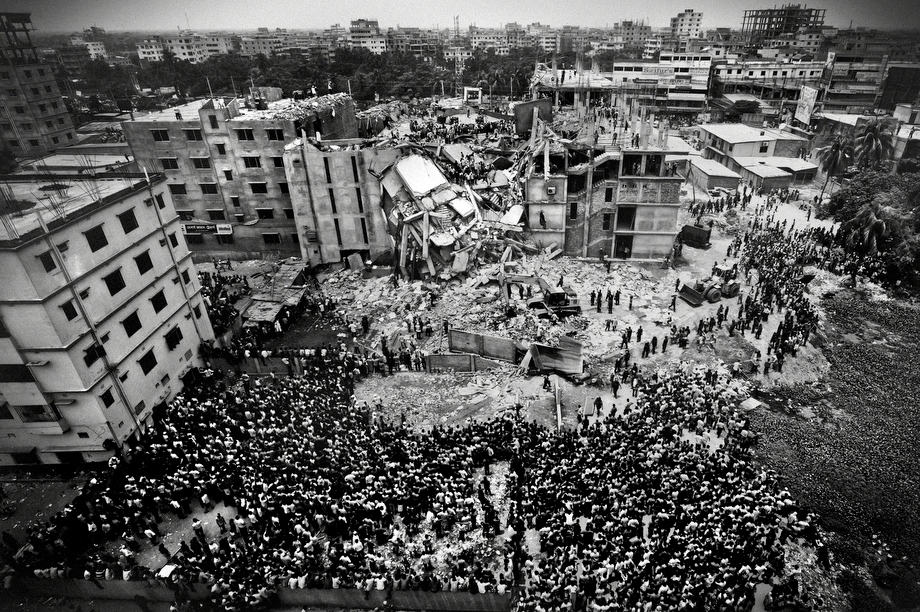
Rescue workers take part in the rescue of the eight-storey building Rana Plaza which collapsed at Savar, outside Dhaka, Bangladesh. Reports state that 1130 workers died and nearly 2500 were rescued alive after the eight-story building Rana Plaza that housed mostly garment factories collapsed on 24 April 2013.
1st Prize: K. M. ASAD, COST OF SLAVERY
“This building will stand a hundred years,” owner boasted just a day before collapse. The next morning, it came down.”Aha re,” the people shook their heads and asked sympathetically So sad.”Shoitaner shoitan,” they cursed the owner of the building. The devil’s devil. The number of dead bodies crossed thousand so fast. Thousands of mourners have gathered at the ruins of a garment factory building (rana plaza at savar) to offer prayers for the souls of the 1,127 people who died in the structure’s collapse 24th april, the worst tragedy in the history of the global garment industry. It came months after a fire at another garment factory in Bangladesh in November killed 112 workers. These two are mentionable , time before also couple of accidents happened and many lost their close ones in those tragedy. Savar tragedy is a symbol of our failure as a nation. The crack in Rana Plaza that caused the collapse of the building has only shown us that if we don’t face up to the cracks in our state systems, that we as a nation will get lost in the debris of the collapse. Bangladesh’s government also agreed to allow garment workers to form unions without permission from factory owners. That decision came a day after it announced a plan to raise the minimum wage in the industry. Many Western companies[clarification needed] which have activities in Bangladesh have engaged in significant public relations campaigns to minimize the fallout from revelations about their worker’s inhumane conditions. Dozens of consumers in the US spoke out against unsafe working conditions found in the factory building. People also unleashed their anger at retailers that did not have any connections to that specific building, but are known to source from factories located in Bangladesh.
Cheap labours, quantity of labourer are blessings for our garment sector. But this blessing turned into curse when all those innocent workers have to sacrifice their lives under poor labour law, unhealthy security system, negligence of their owner. Moreover the government itself. The “Made in Bangladesh” tag has now changed in meaning. It costs bloods to tag a price on those products made by our worker.
It is high time authority took any revolutionary step for the sake of the neglected garment workers. Thousands of garment workers had died. The last breath of those souls surrounds us. Did we learn anything at all from these terrible massacres? Or will we have completed our duty by merely expressing our deep sympathy.
Location: Bangladesh | Photographer: K. M. Asad | Website: www.kmasad.com
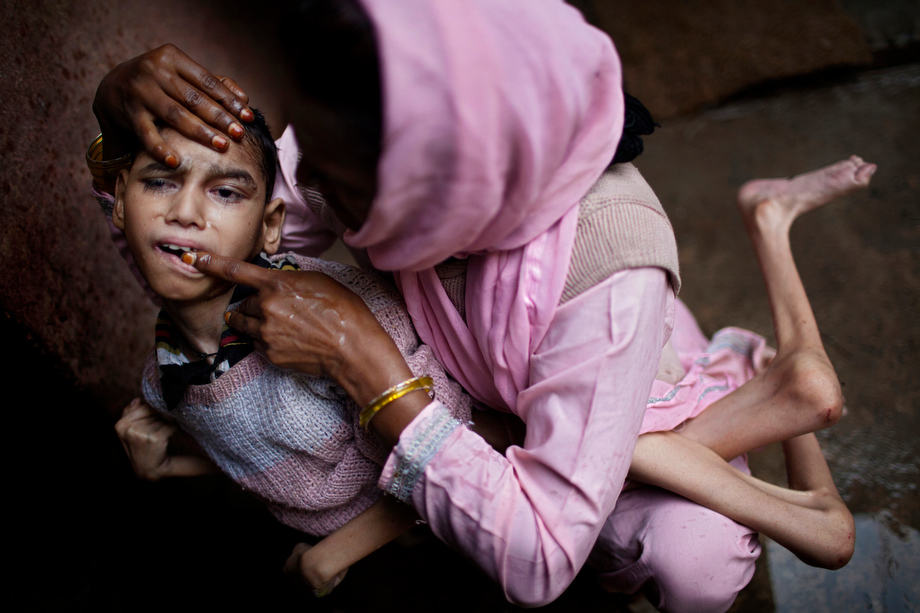
The mother of Samir, 14, a severely disabled boy, is brushing his teeth with her finger while inside their home in Kasi Camp, near the abandoned Union Carbide (now DOW Chemical) industrial complex in Bhopal, Madhya Pradesh, India.
2nd Prize: ALEX MASI, BHOPAL SECOND DISASTER
Bhopal is not yet at peace.
Almost three decades have passed since the 1984 gas disaster, caused by the American corporation Union Carbide – now DOW Chemical – but many families are still trapped inside a nightmare that began on that distant night.
Half a million people were exposed to the toxic cloud released from the plant. Thousands died within a few weeks from exposure.
Presently, a new disaster is taking place in Bhopal: around 100,000 people are chronically ill from the effects of the leak, and dangerous waste has penetrated the underground aquifers widely used for drinking water, harming the health of nearby dwellers. As a grim result, children are increasingly faced by severe neurological and physical disorders.
Since the 2001 acquisition of Union Carbide by DOW Chemical – for a staggering 11.6 billions USD – the American corporation has single-handedly refused to accept any responsibility.
An on-going lawsuit against DOW Chemical in the USA – sponsored by The Bhopal Medical Appeal and other groups of ‘gas survivors’, is pending before the Court of Appeals in New York. It seeks damages for injury, medical monitoring and mitigation.
Paradoxically, DOW Chemical has been awarded a ten-year contract to sponsor the Olympic Movement until 2020.
While documenting the on-going health crisis in Bhopal, I strived to portray my subjects with intimacy, meaning and depth. I aimed to present images that would convey emotion, and inspire our sense of compassion, brotherhood and justice.
I struggled to understand and ‘feel’ the suffering of the affected children and their families. I then allowed it to intimately lead me when it was time to find expression through my images.
In Bhopal, I have met many genuine and welcoming individuals who hold life dear to their heart, and only wish for a better future. They too have inspired me to continue returning to this city, and promoting awareness about the neverending injustice bestowed upon its people.
Location: India | Photographer: ALEX MASI | Website: www.alexmasi.co.uk
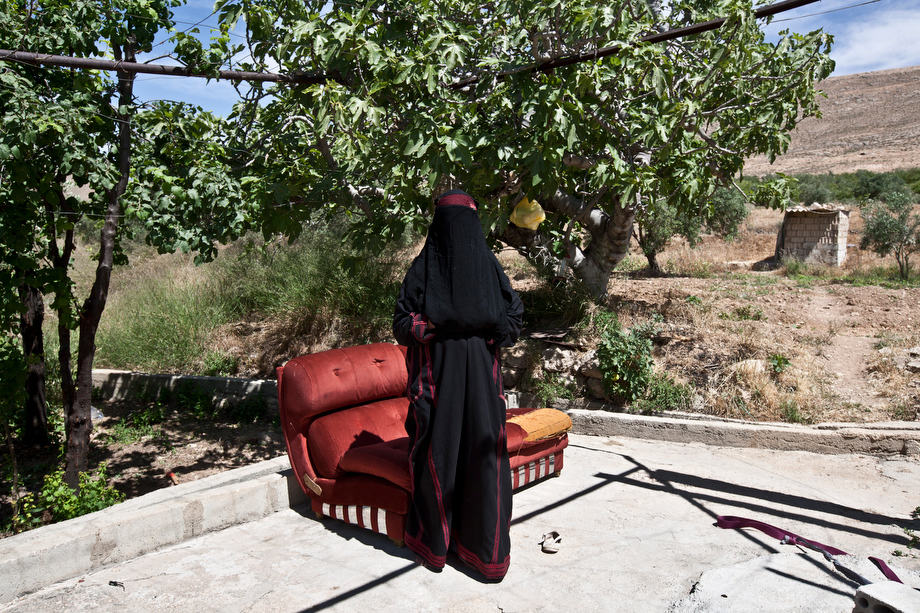
Lebanon – Jdeideh – Najiba, 63 years old, comes from the village of Soran, North of Hama. She arrived in Lebanon eleven months ago, after the first protests erupted in Hama. “The Army was shooting at everyone, I remember seeing 50 or 60 people dead”. She now lives in a concrete shed, in an orchard on the outskirts of Jdeideh. In exchange of looking after the trees, she can stay for free. “I would go back to Syria tomorrow, if it wasn’t for the kids. I am very worried about their safety”, she explains, pointing at the four grandchildren she lives with.
3rd Prize: MATILDE GATTONI, THE SWALLOWS OF SYRIA
Somaya left Homs after finding the corpse of her tortured son in a sewage ditch; Zaynab escaped with her family when she discovered that Syrian soldiers had kidnapped, raped and killed three of her schoolmates; Aziza fled after both her husband and sister-in-law were killed by snipers.
Like thousands of other Syrian women escaped to Lebanon, they are now hiding in small villages within few kilometres from the border, at the mercy of the Hezbollah and secret service agents allied with the Assad regime. Far from the safety of the refugee camps in Turkey, here Syrian women live in constant fear of being kidnapped or killed, hiding all day long in filthy basements and makeshift tents, consuming their last, meagre savings to barely survive in a country that doesn’t want them.
Ignored by the Lebanese government, which refuses to recognize them as refugees, they cannot work and raise money for their families. Separated from their relatives and friends, unable to send their kids to school, some are even starting to question the outcome of the Syrian revolution, regretting the peaceful life they used to live before the Arab Spring.
We have collected the personal stories and pictures of more than twenty Syrian women, recording their feelings of grief, bitterness and hope for the future of their country. All of them are face-covered to protect their safety.
I started covering the Syrian refugees story for The National, an Emirati newspaper and was so frustrated the first day I went to the Bekaa because nobody wanted to be photographed, everybody was scared of the repression and of Hezbollah presence. Men would still go in and out of Syria in order to help their relatives escape, women were terrorized. Then one woman suggested that she could cover her face completely. I did that one shot and when I came home and looked at the picture I thought that could be a story. Women were more precise in telling their stories and it would be interesting to give them a voice in a war that was mostly being told from an FSA (men) perspective.
Matteo accepted to work with me on this and we went back to the Bekaa.
Absolutely none of the women would have allowed me to photograph them without covering their face. Every time we would meet one of them we would explain her what we were doing and why and the first reaction after saying “sura” photograph in arabic would be a very straight forward NO and suddenly their smile would turn into very dark eyes. We would then tell them that their faces would be fully covered and we would show them the first picture I took and slowly some of them accepted, a lot refused. We would never ask their real names in order to make them feel safer, if we didn’t know them how could we publish them?
Women are not covered because they are muslims, they are covered because they are scared to be recognized, they have gone through hell back home.
It was one of the most challenging story I’ve ever covered. We had a great contact on the field, a person who has helped most of the families to cross the border and find a shelter in Lebanon. But still none of the women wanted to be photographed at first, all were extremely scared of being recognized and chased by the Assad regime.
We chose to tell the stories of women who are not registered with the UN (there’s a huge number of them), who don’t live in a camp but who hide in small villages close to the Syrian border.
I worked with Matteo Fagotto, an Italian journalist based in the Middle East. Matteo would first interview them to make them feel at ease, I would add a few questions from time to time that were important in order to get to know them and their stories better, at the end of the chat we would move to a separate part on the apartment (if possible) in order to have a little intimacy with them and take their portrait.
I wanted them to be photographed in the most feminine part of the house, women are able to recreate a warm environment even in the most miserable conditions. It shows an incredible strength and a will to survive no matter what.
Location: Lebanon | Photographer: Matilde Gattoni | Website: www.matildegattoni.photoshelter.com
Special Mention: HASHEM SHAKERI, UNBREAKABLE
Madi’s (my grandmother) life was full of sorrow and happiness with struggles, ups and downs. At younger age she lost two of her children, got separated from her husband who rarely shared a life with her. Soon after he passed away and left her with two daughters. After the death of her husband, his family forbade Madi from the wealth, so she inherited nothing and was left alone in this strange world. With all the difficulties of life, Madi managed to live her life with love and hope, she got through the difficulties of life and brought up her children with dignity. As getting older, at the age of 78, she sold her only apartment to help her daughters to buy two smaller apartments and moved in with one of them in Tehran.
Unfortunately after few years, at the age of 84 (year 2007), she had a hemorrhagic stroke and lost the ability of speaking, reading and writing. In the past years she had few more strokes. Now and then she still gets attacks but with her strong will and belief she keeps on fighting with this illness trying not to depend on others and moves forward to postpone death by living. It is amazing of her; she has created a language which is comprehensive and easy to understand, in order to keep on communicating with the family and making life simpler for them.
Now Madi at the age of 90 with positive energy and inspiration teaches her family lessons of hope and life. Yet this story took more than five years of photographic work since the start of Madi’s brain stroke. During the whole time the only motive of the photographer was the exceptional character, unbreakable spirit, hope and strong belief of this lady, who in the eye of her family is the symbol of love, life and hope.
Location: Iran| Photographer: Hashem Shakeri | Website: www.lightstalkers.org/hashem-shakeri-2
A big thanks to our panel of judges Tay Kay Chin, Pablo Bartholomew, and Yumi Goto. Some words from our Judges….
“I think the overall standard for this photo essay category was very high and for an inaugural award, it is very heartening. It wasn’t easy for me to derive at the final results. On one end of the spectrum were global issues that were hard to ignore, and on the other, personal stories that were also very compelling. Of course there were cliches; fortunately and unfortunately, these sets of images didn’t last very long with me.
As someone who is more of a traditionalist, I gravitated towards good storytelling and that naturally included informative and accurate captions. I also saw a lot of personal style, and in fact in some cases, they were a little too much for me. The problem with style, at least for me, was that after a while, I started noticing the lack of substance even more. The more ‘stylish’ an essay, the more critical I actually became about the content. I wished I didn’t see so many tilted horizon and severely cropped portraits. In comparison, I appreciated a few ‘raw’ essays because I found those photographers more trustworthy.
If I have one big complaint, it has to be the editing. Most of the photographers can shoot but most of them can’t edit. Too many of the essays contained too many images. To me, it demonstrated the lack of confidence in getting the job done in few images. To be totally honest, I looked at many of the essays only for a short time, because I got bored after seeing so many repetitions. In the end, my top three choices were very hardcore reportage. I will not apologize for my seemingly ‘conservative’ decisions because they were all very well done, and I certainly like how current they are. I did like a few artsy and dreamy projects and I believe they were just as important in this competition.
I liked how some photographers could tell a ‘simple’ story so well. But the best thing judging this contest has to be the (re)assurance that many good photographers are in Asia, and looking at Asia. And now that I know some of the names, I will be looking for your works in more places.””
Tay Kay Chin, IPA Photo Essay Asia Award 2013 Judge.
…………………………………………………………………………………………………………………………………………….
“Judging an online completion was a first for me. Normally I love the interaction of sitting in a room and walking and talking through images and entries with my co-judges. So judging alone was a unique experience. It had its pros and cons as all judging scenarios normally do, even the ones with face-to-face interactions.
The advantage for me was that I could look at the work while I was on the road, traveling between several countries.
The submissions overall were very strong, and from what I could make out, came from a wide geographical area, which is healthy and good for first competition run by IPA. This goes to show that IPA has a strong online following and in years I am sure it will grow.
There were some issues that bothered me. For instance, some stories did not have adequate caption information for each of the images, which makes a story suffer and can possibly tilt my judgment to give it a lower ranking. I think the organizers need to ensure that participants put in the barest information, if not good, comprehensive caption information, for each image in their stories.
On the organizer level, it must be ensured that all photographer names or any kind of indications of the photographer’s identity are masked out of the IPTC or image file names so that the judges look at only the work and the relevant information about the images. I noticed a few cases where this was overlooked, though it did not have any bearing on my judgment. I’m bringing it up so as to help improve the process overall.
If there could be an online platform where the judges could interact, it may help. Especially in cases where each one of us maybe familiar with a work or a photographer who has made it, it would be good for the other judges to know the scenario and situation, as in the case when live judging takes place in a room. We all are able tell the others that we know the work or it is made by a photographer who belongs to the same organization they are part of.
Having said all this, I think this is a remarkable endeavor that kept the cost down by cutting out the airfares and hotel room expenses otherwise incurred. It has worked to privilege good work, which is in need of being recognized and awarded, given the fact that the already diminishing editorial world is shrinking year by year. Every competition is as good as the entries it receives. This one, I am happy to say, was a five-star one.
“Cost of Slavery” by K. M. Asad was by far the strongest story both in terms of form and content. Here, the photographer takes a tragic spot news event as his starting point, and then goes beyond it. The reportage goes on to create a complex, nuanced narrative around breaking news events as they unfold. This is what good story telling should be and this is what was achieved. I think the strongest and the best story telling, coupled with compelling image making, in the Asian region is undoubtedly being done by Bangladeshi photographers and some of this credit can be taken by Pathshala the important school of photography based in Dhaka.
A final word for the other entrants: Be brutal when you edit your work. Maybe sit with someone else who can help you weave the story and cut down the excess. And remember that sometimes less is more.”
Pablo Batholomew, IPA Photo Essay Asia Award 2013 Judge.
…………………………………………………………………………………………………………………………………………….
“I was overwhelmed when going through all the high quality photo essay entries which came from every corner of Asia. I appreciated all the applicants and respect their passion and energy.
The photo essays that I am now more interested in are those which have engaged with the photographers’ subjects to such an extent that the work has affected their lives. The distance between the photographer and subject has diminished so the photographer is able to have better understanding and connection, which is then reflected in his or her work.
Matilde Gattoni’s The Swallows of Syria in that sense, highlights a big important issue, yet we can still feel the individual subjects here rather than them belonging to numbers in some statistics. Hashem Shakeri’s Unbreakable and Sarker Protick, What Remains got my attention amongst the finalists too. They are both intensely personal. The connection could have been completed between the photographers and their subjects and not necessarily go anywhere beyond that—but they do.
It is my hope that in turn, these photo essays can engage the audience to promote positive change, whether it is through action or in other ways. Finally congratulations to all, I will keep all works in mind and may our paths cross again In the Future. Till then keep up the great work all!”
Yumi Goto, IPA Photo Essay Asia Award 2013 Judge.
Congratulations once again to all our other Finalists!
1) ILKIN HUSEYNOV, Story Of My Hometown
2) SARKER PROTICK, What Remains
3) GERIC CRUZ, Second Star to the Right
4) TEMO BARDZIMASHVILI, The Unpromised Land
5) CHIARA GOIA, The Secret Circle: Untold Stories of Surrogate Motherhood in India
6) LAM YIK FEI, Mongolian Homeless Children Seek Shelter in Extreme Cold
7) HIROYUKI ITO, Red Rain
8) DO MANH CUONG, Twins
9) KÜRŞAT BAYHAN, Away From Home
10) YUSUF AHMAD, Story Of Illegal Miners Poboya
11) ENRICO FABIAN, Phas Gaya – Being Stuck
12) HISASHI MURAYAMA, The Weight Of Time
13) MARCO PIGHIN, Bajkal
14) SAMSUL ALAM HELAL, Love Studio
15) CHERNYSHOVA ELENA, Norilsk – life at the top of the North
Share

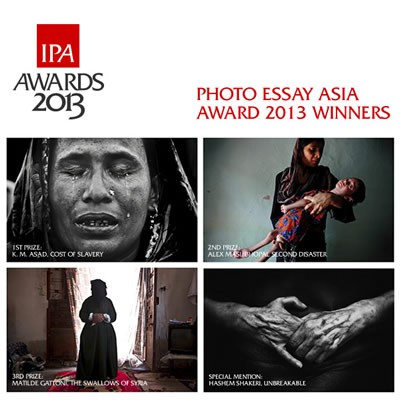
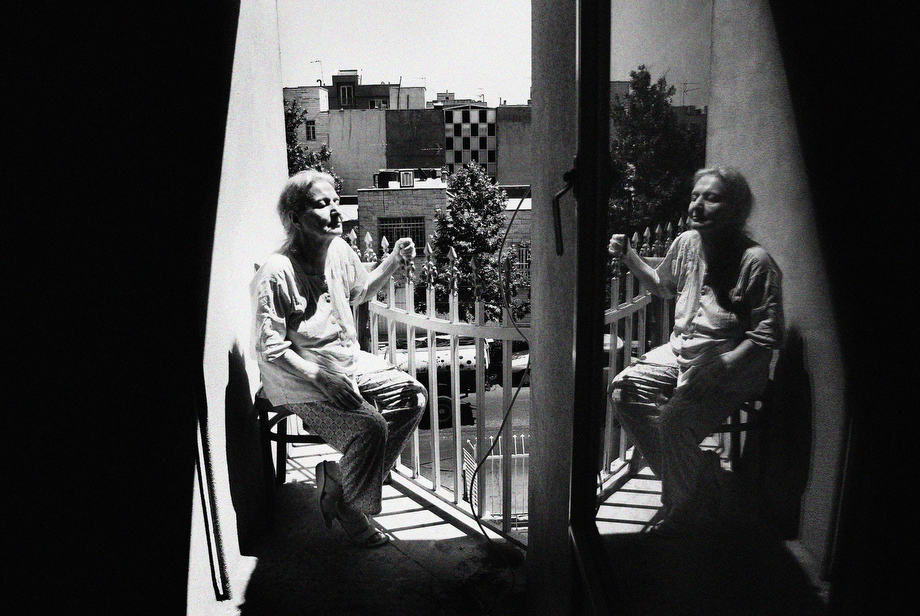
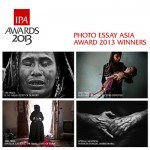
Comments 5
Pingback: K.M. Asad: The Rana Plaza Documentarian - Photographs Magazine
First thanks to all Judged to give your valuable comments and thanks to Invisible Photographer Asia Organizer team also big congratulation all winner and finalist.
Author
Thanks KM Asad. Congrats on being a finalist in our Street Photography contest last year and returning this year to be our 1st Prize Photo Essay Winner. Your support & contribution to photography in Asia is valuable.
Great entries, and worthy winners – congratulations.
Congratulation to all winner & Finalist.